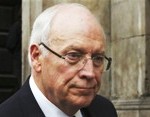 Thomas Geisbert spent the ’90s scraping together funds to work on an Ebola cure. Occasionally, he’d get enough to test a potential vaccine in primates, but the monkeys always died. There was just never enough money.
Thomas Geisbert spent the ’90s scraping together funds to work on an Ebola cure. Occasionally, he’d get enough to test a potential vaccine in primates, but the monkeys always died. There was just never enough money.
The Sept. 11, 2001, terrorist attacks and Dick Cheney helped change that. Cheney, then the vice president, said he feared assaults by bioterrorists could be far more devastating than what happened that day, and became an advocate in the George W. Bush White House for the appropriation of billions of dollars to stop deadly pathogens. Congress agreed, funds began flowing to scientists like Geisbert and breakthroughs followed.
At least seven drugs now being tested — including some used to treat Ebola victims in the U.S. — grew from biodefense measures first approved after Sept. 11. The National Institutes of Health budget for studying potential bioterrorism agents has grown to $1.6 billion from $53 million in 2001, according to Crystal Boddie, an associate with the UPMC Center for Health Security in Baltimore, Maryland.
The U.S. had to take bioterrorism “seriously as a threat in the aftermath of 9/11,” Cheney said in telephone interview. “It has ramifications when the source of the problem you’re dealing with is something like an outbreak of Ebola, but our prime motivation was to make certain we were prepared to deal with an attempt to use those substances in an attack.”
Until recently, there was little profit motive for finding an Ebola cure. Previous outbreaks infected a few hundred, at most, before being contained. This one is on a different trajectory, killing at least 4,900 and infecting almost 10,000 since March, according to the World Health Organization. New infections are projected to reach 10,000 a week by December.
Basic Research
To entice drugmakers to invest in research to fight Ebola and other potential bioterrorism agents, Congress in 2004 passed a law called Project BioShield, allotting $5.6 billion to buy and stockpile drugs to protect against the deadliest infectious diseases. When Bush signed the law, he singled out Cheney as the White House point-person behind the effort.
The U.S. also increased funding for basic research that companies can be hesitant to invest in because of the high risks of failure. NIH’s Ebola funding grew to $42.5 million in 2013 from $840,000 in 2000, according to NIH spokeswoman Jennifer Routh.
Johnson & Johnson’s experimental Ebola vaccine was among those that benefited; the company received a grant worth as much as $30 million from the NIH in 2008. At that time, the vaccine was owned by Crucell, a company J&J bought in 2010, and Crucell’s website then said part of the rationale for developing it was U.S. BioShield money.
Early Technology
J&J said yesterday that it plans to have 250,000 doses ready for human testing in May and another 1 million in 2015, potentially putting it ahead of four other manufacturers in the race for a viable treatment. The company is putting $200 million of its own money into ramping up development, J&J said.
The technology behind two vaccines now being tested by NewLink Genetics Inc. and Profectus Biosciences came out of Geisbert’s lab at the U.S. Army Medical Research Institute of Infectious Diseases. The initial research was paid for by the Defense Department, starting in 2001, with NIH funding later helping perfect the technology, Geisbert said.
Read more from Bloomberg News HERE.
{Matzav.com Newscenter}











